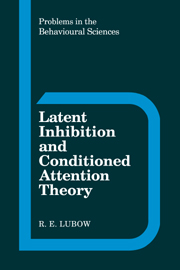Book contents
- Frontmatter
- Contents
- Preface
- 1 Introduction
- 2 Latent inhibition testing procedures
- 3 Variables affecting latent inhibition
- 4 Organismic variables affecting latent inhibition
- 5 Associative learning tests of the effects of stimulus preexposure in children and adults
- 6 Neural substrates of latent inhibition
- 7 Theories and explanations of latent inhibition in animals
- 8 Conditioned attention theory of latent inhibition
- 9 Conditioned attention theory as applied to latent inhibition in humans
- 10 Some applications of conditioned attention theory: learned helplessness and schizophrenia
- Notes
- References
- Author index
- Subject index
- Frontmatter
- Contents
- Preface
- 1 Introduction
- 2 Latent inhibition testing procedures
- 3 Variables affecting latent inhibition
- 4 Organismic variables affecting latent inhibition
- 5 Associative learning tests of the effects of stimulus preexposure in children and adults
- 6 Neural substrates of latent inhibition
- 7 Theories and explanations of latent inhibition in animals
- 8 Conditioned attention theory of latent inhibition
- 9 Conditioned attention theory as applied to latent inhibition in humans
- 10 Some applications of conditioned attention theory: learned helplessness and schizophrenia
- Notes
- References
- Author index
- Subject index
Summary
Modern science has developed to such a point that there are myriad research areas, dark corners as well as bright little chambers, that are penetrated only by a knowledgeable few who happen to be working in a given field – the specialists. I would not be surprised, then, to discover that most of my colleagues, whether they label themselves psychologists, psychobiologists, behavioral scientists, or neuroscientists, do not know what “latent inhibition” is, or at best confuse the term with older research areas that are indeed its distant cousins – latent learning and conditioned inhibition. It is for these readers that I begin this treatise with a definition, as simple as it may be.
“Latent inhibition” is defined by three characteristics. One is concerned with conditions for producing it, the second with the conditions for measuring the effect, and the third with the direction of the differences between groups. More specifically, latent inhibition is the detrimental effect of passive, nonreinforced preexposure of a stimulus on the subsequent ability of an organism to form new associations to that stimulus. To demonstrate latent inhibition, one must preexpose one group of subjects to the stimulus of interest, while not giving such stimulus preexposure to a control group. In the test phase, both groups must learn to form an association between that stimulus and a new event. When the stimulus-preexposed group learns the new association to that stimulus more poorly than does the control group, we say that latent inhibition has been demonstrated.
- Type
- Chapter
- Information
- Publisher: Cambridge University PressPrint publication year: 1989



